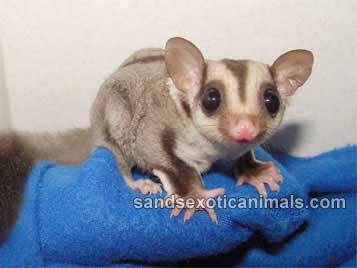
Origin:
Found in the tree tops of Australia, Indonesia and Tasmania.Description:
A sugar glider is a small marsupial possum. They have a preference for sweet foods and a gliding membrane like the flying squirrel. An adult sugar glider is approximately 5 to 6 inches in length with a tail of equal length and weighs from 4 to 5 ounces. Sugar gliders may live 12 to 15 years in captivity.Feeding:
A good diet consists of a combination of fruits, vegetables and commercial sugar glider food. A commercial pellet made by Pet-Pro, Quiko, Pretty Pets or Brisky is also good to include in their diet. We feed a combination of all of these diets mixed together. Fresh fruits and vegetables should be fed once a day. Fresh fruits may include apples, grapes, plums or pears. Vegetables that may be included in their diet are broccoli, sweet potatoes and carrots. A small amount of hard-boiled egg should be added along with a tablespoon of yogurt and a tablespoon of applesauce. Meat and poultry that is lean, cooked (not fried) and de-boned may also be added to their diet. These meats should not have salt, sauces or spices added to them. Processed meats should be avoided. Try to offer a variety of items since all sugar gliders don´t have the same preferences. Live insects such as crickets or mealworms may be included in their diet. Do not feed more than one or two of these insects each evening. Do not collect insects from outdoors where they may have been sprayed with pesticides. Provide water in an open dish and a water bottle. Water is critical to these animals and a clogged water bottle could cause dehydration and death.Housing:
Sugar gliders should be housed in a wire cage and not an aquarium. A wire cage allows them to climb and provides better air circulation. A sugar glider needs a small cage during its first few months to restrict their activity level. When the sugar glider reaches 5 to 6 months of age, a larger cage is appropriate. We use sleeping pouches, cubes and condos for housing. Sugar gliders can exercise inside the cage and branches and bird perches can be spread around so they can jump from one perch or branch to the other. Sugar gliders enjoy playing with bird toys such as swings, perches, ladders and bells. In the cage tray bottom, Carefresh bedding or aspen bedding may be used to help absorb moisture. Temperature should be 65 to 80 degrees Fahrenheit.Bonding:
A bonding pouch is a great idea during the bonding process. It should be made of a material that is easy to breathe through. This pouch should be placed near your body preferably over the heart. By carrying a sugar glider around on your body so that they feel the heartbeat, body warmth and body odor, the bond takes place. The bonding process should be swapped around so the sugar glider will be interactive with everyone and not just one individual.Calcium Deficiency:
Sugar gliders are prone to developing a calcium deficiency. This is due to the fact that they are nocturnal and don´t get sufficient sunlight. You should use a calcium supplement and add liquid vitamins to their water.
Compliments of:
S & S Exotic Animals, Inc., 1711 Connorvale, Houston, TX 77039 (281) 590-0426
http://www.sandsexoticanimals.com
